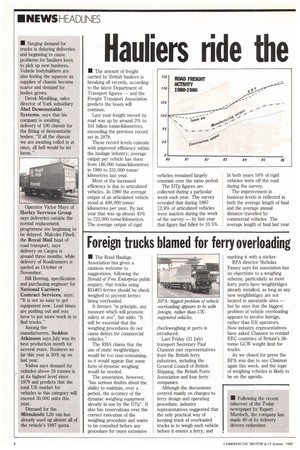auliers ride the freight bonanza
Page 6

Page 7

If you've noticed an error in this article please click here to report it so we can fix it.
• The amount of freight carried by British hauliers is breaking all records, according to the latest Department of Transport figures — and the Freight Transport Association predicts the boom will continue.
Last year freight moved by road was up by around 2% to 101 billion tonne/kilometres, exceeding the previous record set in 1979.
These record levels coincide with improved efficiency within the haulage industry: average output per vehicle has risen from 186,000 tonne/kilometres in 1980 to 231,000 tonne/ kilometres last year.
Most of the increased efficiency is due to articulated vehicles. In 1980 the average output of an articulated vehicle stood at 499,000 tonne/ kilometres per year. By last year that was up almost 45% to 723,000 tonne/kilometres. The average output of rigid vehicles remained largely constant over the same period.
The DTp figures are collected during a particular week each year. The survey revealed that during 1985 12.8% of articulated vehicles were inactive during the week of the survey — by last year that figure had fallen to 10.5%. In both years 18% of rigid vehicles were off the road during the survey.
The improvement in business levels is reflected in both the average length of haul and the average annual distance travelled by commercial vehicles. The average length of haul last year was 73km, while the average annual distance rose from 37,000km in 1985 to 39,000knri in 1986.
This growth of the haulage business over the past five years has largely mirrored the growth in the economy, says the DTp, but it warns: "In the longer term it might be expected that haulage should grow more slowly than the economy as a whole, as is a common feature among developed nations, where an increasing proportion of gross domestic product is derived from service industries."
Much of the growth in recent years followed the increase in the weight limit in May 1983 from 32.5 tonnes to 38 tonnes. Roads and Traffic minister Peter Bottomley estimates that this move has saved British hauliers some £100 million and reduced the number of commercial vehicles currently operating on British roads by around 16,000.
"I am pleased," says Bottomley, "to note that the Government's decision to allow 38-tonne lorries on Britain's roads has led to gains in efficiency for the haulage industry, and to environmental benefits for the rest of the community."
The DTp estimates that 38tonne lorries comprise around 7% of our commercial vehicle pare, yet last year top-weight lorries accounted for over 30% of all goods movements. The top weight limit also reduced the total distance travelled by commercial vehicles by around 480 million kilometres last year, claims the DTp.
The Freight Transport Association says the DTp figures show how well the haulage industry has responded to the rise in weight limits: "The figures show that the change in 1983 was very, very important and valuable for industry as a whole, and that the freight transport industry has responded with heavy capital investment in new vehicles."
Since 1986 total operating costs to industry have fallen by around 2251 million as a result of the introduction of 38 tonnes, says the FTA's Richard Turner, thanks to a resulting fall in freight charges. The change in weight limits has also reduced road wear, claims Turner, as the extra weight is carried on a fifth axle, and because there are now fewer lorries on the road.
Industry buoyant
"All the indications on vehicle mileage, sales and leasing suggest that the industry is very, very buoyant at the moment," says Turner. "We are extremely confident that 1987 will beat the record levels of 1986."
The Road Haulage Association, however, warns: "It is necessary to dispose of the implied suggestion in the report that hauliers have benefitted from reduced costs since the introduction of 38tonne lorries in 1983. The total beneficiaries have been the hauliers' customers and ultimately the consumers of goods."
There is clear evidence in the report of a move away from own-account haulage to contract distribution, says the RHA's Derek Witcher: "Some 56% of the tonnage lifted and 68% of tonne/kilometres moved are now handled by the hire-and-reward sector, compared with 52% and 62% respectively five years ago."
The environmental pressure group Transport 2000 says of the DTp report: "It is nice to think that there are fewer lorries on the road since the introduction of 38 tonnes, but it must be remembered that these heavier lotzries are the most environmentally damaging."
Transport 2000 is keen to encourage the development of smaller 'city-friendly' lorries and hopes the Channel Tunnel will draw freight traffic back from road to rail.
































































































